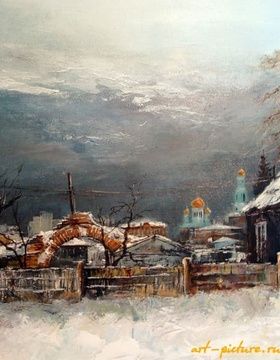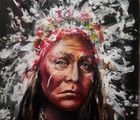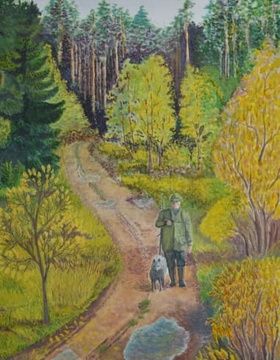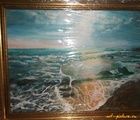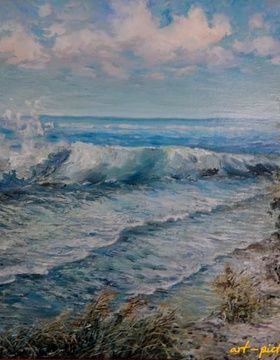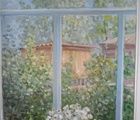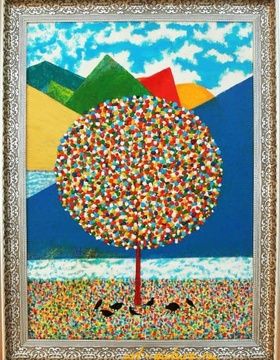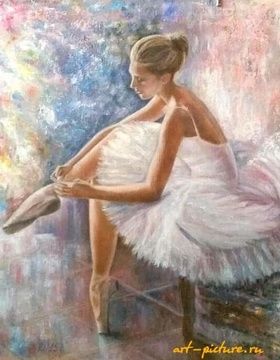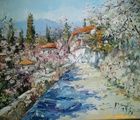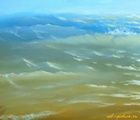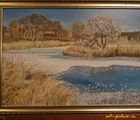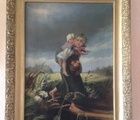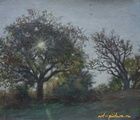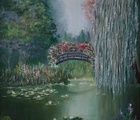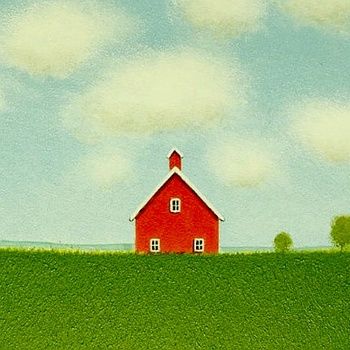
До эпохи Возрождения пейзаж выполнял декоративную функцию. Но прежде чем пейзаж стал носителем идеи и прежде чем начал помогать раскрывать характер главных героев, а уж тем более обрел самостоятельность, прошло очень много времени.
Как зарождался жанр пейзаж?
Впервые изображение природы мы встречаем на рельефах древних цивилизаций, которые возникли на берегах могучих рек. На картинах или скульптурах, дошедших до наших дней, пейзаж представляет собой редкие образцы флоры. И только в эпоху Ренессанса, когда у итальянцев проснулся интерес к натуре, пейзаж отвоевал себе место под рампами.
Обращение к природе происходит синхронно с пробуждением человеческой пытливости. Человек пытается разобраться, что в нем сильнее – духовное или материальное? Что является смыслом жизни или что приносит счастье?
Немцы считали, что природа привносит в жизнь человека сумбур. И уж если в человеке побеждают инстинкты — жди беды. Итальянцы были не согласны со своими северными коллегами, они находили, что только баланс двух начал в человеке может дать гармоничную личность. Тициан и Джорджоне воплощали эту идею в своих картинах, в то время как Рафаэль отдавал дать уважения городскому пейзажу, наслаждаясь стройностью линий. Эпоха романтизма возникла в противовес эпохи Просвещения, чтобы восстановить нарушенный баланс. Чувствуя, что человеческая мораль и нравы далеки от совершенства, художники обратились к природе. Сезоны года были призваны отражать состояния человеческой души. Наконец, натура к XIX веку возобладала.
Особенности пейзажа в живописи
Своеобразие пейзажа зависит от места, которое отводится пейзажу на картине, и индивидуальному восприятию художниками природы. Кульминация жанра пейзаж
Французы рисовали природу, пытаясь изобразить все ее многочисленные оттенки и настроения. Начиная с Коро и вплоть до импрессионистов, пейзаж переживал годы триумфа. Старшие импрессионисты — К. Моне, К. Писсарро, А. Сислей уже работали исключительно на свежем воздухе, чтобы не допустить и малейшего искажения. Пресловутая световоздушная среда, которая на картине соединяла природу и человека воедино, прочно вошла в анналы искусства.
Появились пейзажные серии, объединенные одним мотивом. Импрессионисты одинаково уважали и сельский, и городской пейзаж. Но пейзаж как вид искусства не мог стоять на месте и должен был развиваться. Сезанн, Жорж Сёра и Ван Гог привнесли в пейзаж свое характерное видение. Природа Поля Сезанна величественна, монументальна, она имеет четкие границы. Жорж Сёра играл с оптическим эффектом, воздействуя на зрителя цветом. Его мозаичные картины стилизованы, декоративны. Неистовый Ван Гог в своих картинах изливал душу, он использовал природу как рупор, чтобы донести до зрителя свою боль от сознания несовершенства человека.
Поль Гоген замыкает строй постимпрессионистов, его творчество близко к символизму, где природа лишь отдаленно напоминает свой прототип. Его цветовые плоскости, заменившие форму, обладают категоричным звучанием. Особенности пейзажа в живописи на картинах русских художников
Русские художники Саврасов и Шишкин также оказали влияние на развитие жанра. На своих картинах они любовно изображали русскую природу — степи и озера, поля и леса. Торжество сельской жизни на Руси было выполнено в духе среднеевропейского пейзажа. Неяркие краски как нельзя кстати подошли к русским просторам. Морские пейзажи получили мировую известность благодаря Айвазовскому, который достиг недосягаемых высот в этом жанре.
Французский импрессионизм нашел отклик в работах Серова и Коровина, работы которых получили признание. Советские художники — Крымов, Грабарь — манифестировали красоту человеческого труда, идущего рука об руку с природой. Процесс урбанизации также оказал влияние на мир искусства. Сегодня из плеяды талантливых художников можно выделить Василия Афанасьевича Лескова, его картины непредсказуемы и очень эффектны.
На протяжении веков роль пейзажа в искусстве постоянно менялась, а мастерство художников неукоснительно росло. Современные художники пользуются большой свободой при выборе средств выразительности и техники. Если вы хотите, чтобы ваш дом украсил пейзаж, способный воспламенить воображение, заказывайте картины у настоящего мастера.
Поджанры пейзажной живописи
По типу изображенных мотивов пейзажи делятся на многочисленные категории:
- сельские;
- городские;
- архитектурные;
- горные, морские, лесные и т.д.
При классификации по широте охвата пейзажи разделяют на камерные и панорамные.
В зависимости от сюжета различают следующие виды пейзажей:
- эпические;
- исторические;
- героические;
- лирические;
- романтические;
- фантастические;
- абстрактные и т.п.
Знаменитые мастера и работы в жанре пейзажа
Жившие в разные эпохи в различных частях света мастера пейзажа оставили миру свои бессмертные творения:
- Эль Греко, «Вид Толедо»;
- Питер Брейгель Старший, «Охотники в снегу»;
- Клод Лоррен, «Пасторальный пейзаж»;
- Джон Констебл, «Телега для сена»;
- Кацусика Хокусай, «Ясное небо с тридцати шести видов горы Фудзи»;
- Томас Коул, «Вид с горы Холиок»;
- Клод Моне, «Восход»;
- Иван Айвазовский, «Вид Константинополя и Босфора».


